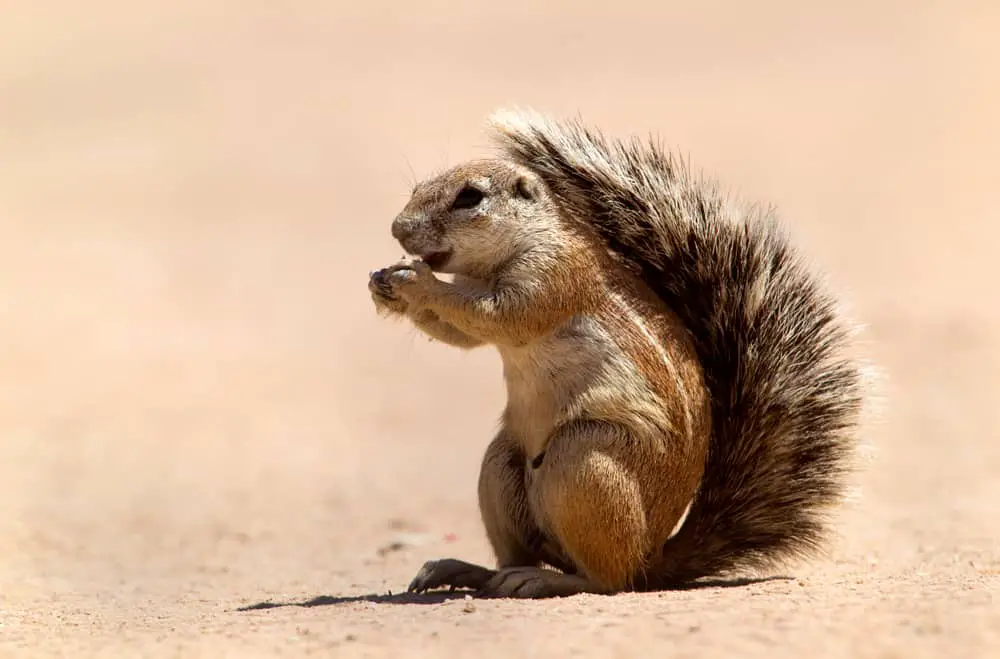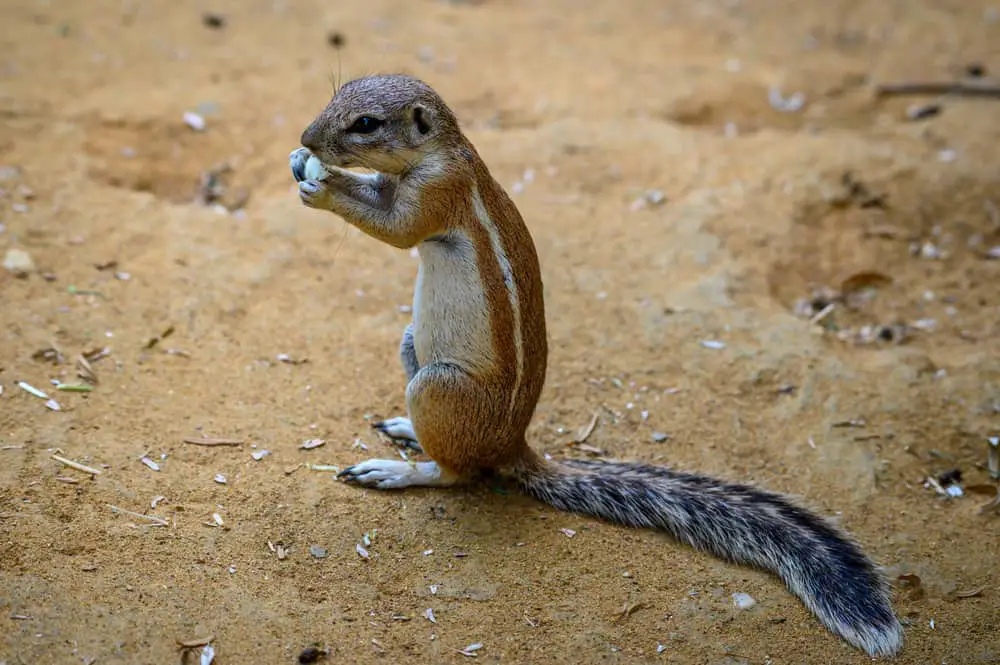Xerus is a genus of ground squirrels known for its highly adapted behavior, physical characteristics and impressive intelligence. They are found primarily in Africa but also in parts of the Middle East and India.
Xerus have long been renowned among zoologists as one of the most fascinating species to study due to their remarkable capacity for learning, problem solving and memory recall. This article explores some key aspects of xerus biology, ecology and behavior that set it apart from other members of the rodent family.

Types Of Xerus
| Common Name | Scientific Name | Location |
|---|---|---|
| Striped Ground Squirrel | Xerus erythropus | Sub-Saharan Africa |
| Unstriped Ground Squirrel | Xerus rutilus | Sub-Saharan Africa |
| Damara Ground Squirrel | Xerus princeps | Southern Africa |
| Mountain Ground Squirrel | Xerus gularis | Eastern Africa |
| Smith’s Bush Squirrel | Xerus smithii | Southern Africa |
Xerus is a genus of squirrels that inhabit parts of Africa. There are three types of xerus, the rock-dwelling, burrowing and tree-dwelling species.
The rock-dwelling xerus inhabits rocky areas in savanna habitats as well as scrubland. These animals have adapted to their natural environment by digging into crevices between rocks for shelter. They also feed on grasses, herbs, roots and shoots found in these areas.
Burrowing xeruses create extensive underground tunnel systems with multiple entrances and exits leading to safe havens beneath the ground.
In contrast, tree-dwelling species make their home among the branches of trees in wooded habitats. Their diet consists mainly of fruits, nuts and seeds from the canopy above them.
Xeruses use their long tails for balance when navigating through dense foliage or running across branches. All three utilize unique adaptations to survive in various ecological niches throughout Africa. As agile climbers and skilled diggers, they can quickly relocate if necessary or access hard-to-reach food sources hidden within their habitat’s complex network of vegetation and terrain features.
Habitat And Distribution
The Xerus is a typical inhabitant of many African countries, and its range stretches from the Sahara Desert in the north to parts of South Africa. It lives predominantly in dry areas such as savannas, plains, shrublands and grasslands. The following are some key points about the xerus habitat:
- Its natural environment offers plenty of cover for protection against predators.
- Despite being an omnivore, it requires a wide variety of foods to survive, which can be found within its home range.
- It has specific requirements when it comes to temperature, humidity and soil moisture – all of which need to be met for optimal living conditions.
Xeruses have also been known to live in more urban environments such as parks or gardens where there may not be sufficient food sources available naturally but there are plenty of man-made ones like discarded fruits and vegetables.
This means that they do not always need access to their traditional habitats for sustenance and can adapt to new environments quite easily. Additionally, xeruses are able to travel long distances very quickly, making them highly mobile animals with no clear boundaries on their distribution ranges.
Despite this mobility, however, they still require certain environmental factors in order to thrive – mainly those related to climate and vegetation availability.
Even though they are considered one of the most widespread species among small mammals in Africa, their ideal habitats must still meet particular criteria before they will settle down and make it their home.
Physical Characteristics
The physical characteristics of a xerus are distinguishable across its range. Its coat is made up of short, dense fur that ranges in color from yellowish-brown to reddish-gray and occasionally white. The size of the xerus varies widely depending on geographic location.
They typically measure between 35–50 cm (14–20 inches) in body length, with tail lengths ranging from 20–30 cm (8–12 inches). Xeruses have a small pointed head and an elongated body shape, which helps them navigate through tunnels or crevices when foraging for food.
Xeruses possess sharp claws and long whiskers which aid in their detection of subterranean prey such as insects, worms, roots, and bulbs. Furthermore, their large ears help them detect sound vibrations underground.
This adaptation allows them to capture more prey than if they lacked this particular trait. In addition to these features, xeruses also have thickly padded feet that provide traction while traversing rough terrain and burrowing into soil or sand.
Due to specialized adaptations like those described above, the xerus has been able to thrive despite human influence on its habitat and distribution. These adaptive traits allow it to continue thriving both below ground and aboveground today, making it one of nature’s most successful species.
Diet And Feeding Habits
The xerus is a small mammal native to Africa and the Middle East. Its diet consists of fruits, seeds, roots, insects and other invertebrates. It has adapted well to its environment by taking advantage of different sources of nutrients in order to meet its nutritional needs.
| Feeding Habits | Nutritional Needs |
|---|---|
| Foraging behavior Scavenging activities Fruits & Seeds Invertebrates | Variety of foods High protein content Essential vitamins & minerals Carbohydrates & fats |
Xeruses are opportunistic feeders that will take any food available when foraging or scavenging, but they prefer fruits and seeds over other sources of nutrition. They also consume more than their fair share of insects like beetles, caterpillars and grasshoppers.
In addition to these food items, the xerus must obtain essential vitamins and minerals from its diet in order to remain healthy and active. Carbohydrates and fats are also important components of their diets as they provide energy for activity levels throughout the day.
Due to their size and relatively slow movement relative to larger animals, xeruses have evolved strategies such as digging around plants’ roots looking for food or waiting near termite mounds so they can catch emerging prey quickly before it escapes into deeper burrows. This allows them access to a wide variety of nutrient-rich resources which provides them with enough energy and nutrition needed for survival.
Overall, the diet of the xerus requires a great deal of flexibility due to its need for multiple sources of food in order to meet all its nutritional requirements. Their ability to adapt quickly has allowed them to survive even during times when there is limited availability of certain types of food within their habitat range.
Reproduction And Lifespan
Xerus is a solitary creature, and mating only takes place during the spring season when they come together to breed. During breeding, one female xerus will mate with multiple males in order to ensure genetic diversity within her litter.
After mating, gestation of the offspring lasts for approximately seven weeks. Litter size ranges from 1-3 cubs on average, but can be as large as 5 or 6 cubs per litter if conditions are favorable.
At birth, xerus cubs are born blind and weigh about 200 grams each. Both male and female parents take part in raising their young until they reach sexual maturity at around 10 months old.
Once mature, young xeruses must find a new territory as adults have exclusive possession over theirs. In terms of longevity, wild xeruses typically live between 3-5 years while those kept in captivity can survive up to 8 years depending on their environment and care routine.
The lifespan of a xerus is heavily dependent upon its ability to obtain food resources throughout its life cycle; this means that those living in areas with abundant sources tend to live longer than those residing in more hostile environments with fewer resources available.
Behavior And Social Structure
Xerus are highly social animals, having complex communication systems and group dynamics. They demonstrate a variety of different behavioral patterns that can be observed in their daily activities. These behaviors range from vocalization to facial expressions and body language. This behavior is used as an expression of emotion or for establishing dominance within the group.
Xeruses exhibit several forms of social behavior, including grooming each other, playing together, forming alliances with one another, and displaying aggression toward members outside the family unit. In addition to these behaviors, they also have distinct social structures which involve hierarchies based on size and age.
The dominant male will lead the pack while the subordinate females follow his lead. There is also evidence that xeruses use certain strategies when interacting with unfamiliar individuals, such as standing upright for a better view or retreating under cover when threatened by predators.
These observations suggest that xeruses possess sophisticated ways of communicating with both familiar and unfamiliar individuals, allowing them to form successful social relationships among themselves as well as with other species.
By understanding how xeruses interact within their own environment, researchers are able to gain insight into their unique communication systems and group dynamics which help shape their behavior and overall social structure.

Conservation Status
The xerus is an endangered species, with some estimates indicating that their population has decreased by as much as 80 percent in the last decade. This decline has been attributed to a combination of habitat destruction and overhunting for its fur. As such, conservation efforts are crucial to ensure that this species does not become extinct.
One method being used to protect the xerus involves creating protected areas where they can live without fear of predation or exploitation from humans. In addition, captive breeding programs have been initiated so that individuals may be released back into the wild once conditions are suitable. Furthermore, research projects have been conducted to understand more about the ecology and behavior of the species in order to inform effective management plans.
In recent years there have also been attempts at raising public awareness about the plight of the xerus, through campaigns highlighting its declining numbers and threats posed by human activities. This increased attention has resulted in donations towards conservation initiatives which aim to restore balance within habitats affected by development and other disturbances caused by humans.
These measures show promise for ensuring a future for this unique mammal, however further action needs to be taken if we hope to secure it’s long-term survival in our world today.
Conclusion
Xerus are small, burrowing animals that can be found throughout Africa. These creatures have adapted to a variety of habitats, from arid grasslands to dense forests and swamps. They possess specialized physical characteristics such as long claws on their front legs for digging and short ears that help them stay cool in hot climates.
Their diet consists primarily of insects, plants, and occasionally other small animals. Xerus reproduce through internal fertilization and the gestation period is around 90 days with an average lifespan of 8-10 years in the wild. In regards to behavior and social structure, xerus live in colonies where they exhibit various forms of communication including calls, postures and movements.
The conservation status of xerus varies depending on location but overall these animals are not considered endangered or threatened species at this time. Despite being relatively common however, there has been little research into their ecology or natural history due to their size and secretive behaviour which makes it difficult to observe them in their native habitat.
Therefore further study is required in order to fully understand the factors influencing population dynamics so appropriate management strategies can be implemented if necessary.
In conclusion, xerus are unique mammals that have adapted well to many different environments across Africa. Despite living amongst humans they remain elusive due to their nocturnal habits making them difficult to study directly; thus more research is needed in order to gain insight into population trends and environmental pressures affecting these fascinating creatures before any conservation action can be taken effectively.

